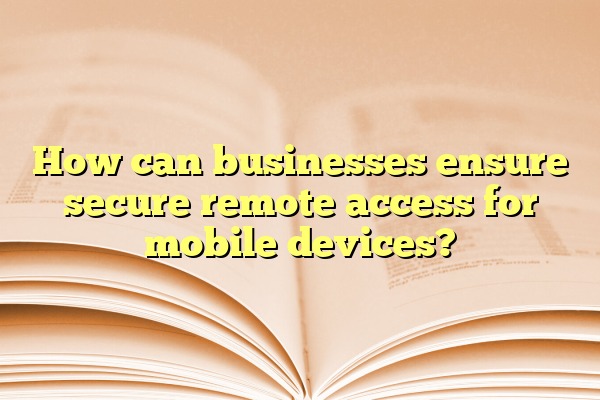
How can businesses ensure secure remote access for mobile devices?
In an increasingly digital and mobile-first world, businesses are embracing remote work opportunities to stay agile and competitive. With this shift comes a critical need to secure remote access for mobile devices. Whether it’s a smartphone, tablet, or laptop, ensuring these endpoints can connect securely to corporate networks is essential for safeguarding sensitive data and maintaining compliance.
Why Secure Remote Access Is Crucial
As employees access company resources from various locations using multiple devices, the organizational attack surface expands. Cybercriminals often target mobile endpoints as entry points into the network. Without the right safeguards, the risks include data breaches, ransomware attacks, and the compromise of confidential business information.
So how can businesses strike a balance between accessibility and security? Here are some essential strategies to ensure secure remote access for mobile devices:
1. Implement Multi-Factor Authentication (MFA)
One of the simplest and most effective ways to boost mobile security is by implementing multi-factor authentication. MFA requires users to verify their identity using at least two forms of verification, typically a password and a secondary factor like a text message code or biometric scan.
- Reduces the chances of unauthorized access even if credentials are compromised
- Supports compliance with data protection regulations
- Can be deployed across most mobile and enterprise platforms
2. Use Virtual Private Networks (VPNs)
VPNs encrypt data transmitted between mobile devices and company servers, offering a secure tunnel that ensures sensitive information remains protected even on public networks.

Modern VPN solutions can be tailored for mobile devices, providing seamless background operation that doesn’t interrupt user workflow. For added security, businesses can opt for split tunneling to route only specific traffic through the VPN.
3. Deploy Mobile Device Management (MDM) Solutions
Mobile Device Management allows IT administrators to monitor, control, and secure mobile devices used by employees. With an MDM system in place, organizations can:
- Enforce security policies like screen locks, encryption, and strong passwords
- Remotely wipe data from lost or stolen devices
- Push updates and patches to ensure devices are running the latest software
MDM not only helps protect the device itself but also ensures that only compliant devices can access corporate resources.
4. Leverage Zero Trust Architecture
The zero trust model operates on the principle of “never trust, always verify.” Rather than assuming that devices inside the network are safe, zero trust ensures continuous verification of both users and devices before granting access to resources.
Key components of a zero trust approach include:
- Context-aware access controls
- Continuous authentication and monitoring
- Micro-segmentation of networks to limit lateral movement of threats
5. Educate Employees on Security Best Practices
Technology alone won’t secure mobile access—employee awareness is equally vital. Businesses should provide regular training and updates on topics such as:
- Recognizing phishing attempts and malicious apps
- Using secure Wi-Fi networks
- Implementing secure password practices
Having a well-informed workforce significantly reduces the risk of user-related security breaches.

6. Use Secure Access Service Edge (SASE)
SASE combines networking and security functionalities into a cloud-based framework, ensuring secure and efficient access to resources regardless of the user’s location. It integrates services such as firewall-as-a-service (FWaaS), secure web gateways (SWG), and cloud access security brokers (CASBs).
For businesses supporting a distributed workforce, SASE provides scalable protection that extends seamlessly to mobile devices.
7. Conduct Regular Risk Assessments
Cyber threats evolve rapidly, and so should your security policies. Regular assessments help identify vulnerabilities and adjust strategies accordingly. It’s crucial to evaluate:
- Device usage patterns
- New OS or app vulnerabilities
- Employee feedback on usability and security concerns
Conclusion
Ensuring secure remote access for mobile devices is more than a technical requirement; it’s a strategic priority for modern businesses. By leveraging a combination of technologies like MFA, VPNs, MDM, and SASE, along with a strong culture of security awareness, companies can protect their data and sustain productivity in a mobile world. As threats continue to grow in complexity, staying proactive and adaptive is key to maintaining cybersecurity resilience.
